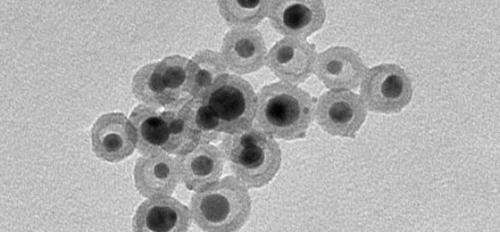Synthesis process to encapsulate nanoparticles that could improve antimicrobial coatings

Chemists supported by the Swiss National Science Foundation (SNSF) have developed a one-pot synthesis process to encapsulate nanoparticles. This type of particle could improve the antimicrobial coating of implants.
Western populations live longer while enjoying good health. More and more people, for example young pensioners, have implants fitted to pursue their activities. But such surgery is not without its risks: during an operation, bacteria can reach the surface of the implant. Once they have colonised the surface and formed a biofilm, the implant has to be removed and the wound cleaned. No new implant can be fitted till the infection has cleared up completely. These complications affect 2% of artificial hip joints, 5-10% of artificial knee joints and reach 50% for cardiac shunt and stent operations.
One way of fighting the growth of bacteria on the surface of the implant is the addition of an antimicrobial coating. A research group, led by Katharina Fromm of the University of Fribourg, has developed such a coating. It is currently undergoing in-vivo tests in a project funded by the CTI. This coating continually emits an antimicrobial agent - silver ions - for the duration of approximately three months.
Coating with longer effect
To prolong the efficiency of the coating, the researchers are currently working on a second-generation coating in which the silver nanoparticle would be encapsulated in silica. This would enhance the stability of the nanoparticle by isolating it from its environment. It would also slow down the diffusion of the silver and prolong the efficiency of the coat-ing. Another advantage of this method is that cells can tolerate a much greater number of silver nanoparticles if they are encapsulated than if they are naked.
To this end, the researchers have developed, within the context of the National Research Programme "Smart Materials" (NRP 62), a one-pot synthesis process (*) to encapsulate the nanoparticles. This allows them to determine the porosity and the size of the silica container in relation to the nanoparticle it contains. Under the microscope, it looks like a nanoscopic rattle.
Targeted release
To improve the performance of the coating even further, the researchers - in collaboration with Prof Christian Bochet's group - are also working on bacterial sensors which they aim to attach to the encapsulated nanoparticles. If such a sensor were in place, the silver would only be released if a pathogen were nearby. This targeted release would further prolong the efficiency of the protection and it would prevent silver from being needlessly released into the organism.
The synthesis developed by the researchers allows for the development of various types of containers for various nanoparticles. The application potential for these nano-rattles is therefore considerable: by con-trolling the porosity of the container, it is for example possible to con-trol which molecules can get close to the nanoparticles. This, in turn, would make it possible to create a nanoreactor in which a chemical reaction can take place. The technique might also enable new battery designs in which each encapsulated nanoparticle would play the role of an electrode.
More information: For more information, see: www.nfp62.ch/E/Pages/home.aspx
Provided by Swiss National Science Foundation



















